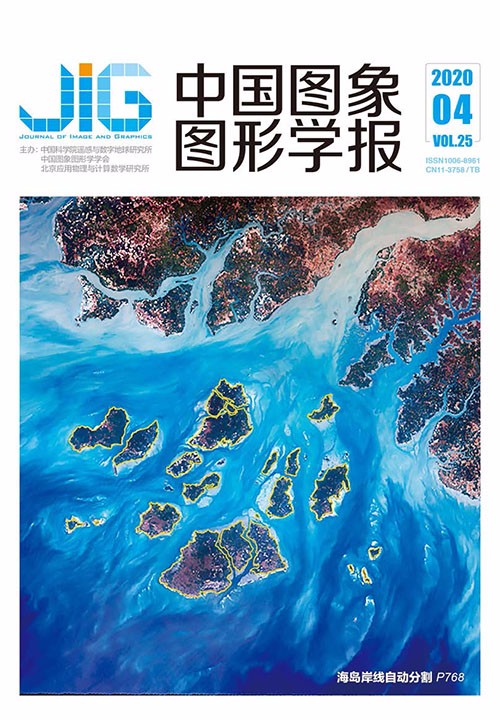
结合曲率滤波的HTM算法去除遥感影像云雾
摘 要
目的 遥感卫星幅宽较大,成像区域内的薄云和雾很难区分,云雾降低了遥感影像的解译精度和对目标地物判别的准确性。传统的云雾去除方法是通过调整图像的对比度和饱和度来提高重建图像的质量,对不均匀分布云雾的适应性不强。为此,本文以"高分二号"(GF-2)遥感数据为例,提出一种结合高斯曲率滤波的雾度图(haze thickness map,HTM)求解算法。方法 采用遥感影像的红波段进行HTM求解,首先通过不重叠的滑动窗口对整幅图像取暗像素,得到HTM估计值,利用高斯曲率滤波对其进行平滑,减少噪声干扰,保持地物边缘特征,并通过插值运算恢复到原图尺寸;然后利用改进的2维最大熵自动确定分割阈值,提取HTM中白色区域并抑制,对边缘处的像素值进行校正;最后通过HTM结果恢复出清晰影像。结果 由目视判读结合评价指标进行评价,将改进的暗原色先验法、传统的HTM算法与本文改进的方法在不同地区含云雾的遥感影像上进行对比实验。本文改进方法所得结果与传统方法相比,灰度均值降低约34.96%,平均梯度提升约18.48%,信噪比提升约34.77%,对比度提升约39.41%,对于不均匀遮挡的云雾去除具有较好效果。结论 改进的方法能够去除云雾干扰,有效改善影像数据的视觉效果,同时能够保留大量的细节信息,较传统方法更优。
关键词
Haze and cloud removal from remote sensing image using HTM algorithm based on curvature filtering
Yang Keke, Jia Yuan, Shen Chuan(School of Cormputer Science and Technology, Southwest University of Science and Technology, Mianyang 621000, China) Abstract
Objective The classification of different earth objects is an important task in remote sensing image processing. However, the classification results are highly sensitive to weather conditions, especially haze and cloud. The cloud is different from the haze, but distinguishing between a thin cloud and haze is difficult due to the large coverage width of the remote sensing satellite. These weather conditions degrade the features of earth objects and decrease the interpretation accuracy of the features as well as the classification accuracy of different earth objects. The conventional methods of haze and thin cloud removal are designed to obtain the haze-free image by adjusting the contrast and saturation. Representative methods mainly include image dehazing algorithms based on the atmospheric scattering model and image contrast enhancement algorithms based on frequency domain analysis. The former is one of the most common methods which combined with the atmospheric physical model, can effectively remove haze and thin clouds. However, this model is complex and many of its parameters need to be set artificially if no appropriate constraint conditions exist, and new noise interference appears during the process of haze and cloud removal. Therefore, the dark channel prior (DCP) algorithm simplifies this model through prior knowledge, which makes haze and cloud removal easier and more efficient. Another method uses frequency domain analysis to enhance the image contrast, this method restores images by maximizing their contrast locally. However, this method does not combine with atmospheric scattering model and cannot be applied to complex scenes. In addition to these methods of haze and cloud removal with a single image, the multitemporal remote sensing image is used to remove the cloud by comparing these images of the same area in different periods. However, this type of method requires complicated image sampling and processing procedures. Therefore, the research on haze and cloud removal with a single remote sensing image is important. The GF-2 satellite is the first civil optical remote-sensing satellite independently developed by China with a spatial resolution better than 1 m. Haze and cloud regions are observed in the optical remote sensing images of southwestern China collected by GF-2. In this study, the southwestern region was selected as the study area. A haze thickness map (HTM) algorithm combined with Gaussian curvature filtering was proposed to remove the haze and cloud for GF-2 optical images. Method Weather factors cause visible light scattering when the scattered natural light is added to the target objects, and leads to the degradation of a remote sensing image. The traditional HTM algorithm achieves haze removal by calculating the HTM to represent uneven haze. The HTM is derived from the technology of dark-object subtraction. In this paper, the HTM is calculated by searching dark pixels using a local non-overlapping window for the entire image in red band, and smoothed by Gaussian curvature filtering and interpolated up to the size of the original band. The curvature filter can reduce noise interference during image processing and effectively preserve the edge information. Compared with guided filtering and bilateral filtering, this method can improve accuracy and preserve the local details of the image better. The improved 2D maximum entropy is used to automatically determine the segmentation threshold by extracting and correcting the highly bright patches in HTM to improve the accuracy of the obtained HTM. In a local area at the edge points, the HTM values have small variation and the haze is usually in the low-frequency part of the image, thereby correcting the pixel values at the edges by replacing the minimum with the mean. Finally, a haze-free image is restored by precise HTM. Result Five types of images were selected and degraded by uneven haze and cloud from different regions for comparison. The evaluation results demonstrated that the improved method is superior to the conventional methods. In this paper, the improved DCP, traditional HTM algorithm, and improved algorithm are compared. Four evaluation indicators including the average grayscale, average gradient, signal-to-noise ratio (SNR), and contrast are used to compare the image de-hazing quality of the different methods. The average grayscale value can reflect whether the dehazing is effective. As the cloud is removed, the average grayscale of the image decreases. The average gradient reflects the details of the image and the change in texture information. The SNR can reflect the noise level such as haze and cloud. The contrast can reflect the clarity of the image. The results of the improved algorithm show that the average grayscale is reduced by 34.96%, the average gradient is increased by 18.48%, the SNR is increased by 34.77%, and the contrast is increased by 39.41%. The qualitative and quantitative experimental results demonstrate that our method can deal with uneven haze and cloud, and the dehazing result is superior to the conventional methods. Conclusion In this study, the haze and thin cloud are processed based on the traditional haze detection method. The results show that the improved method is suitable for uneven haze and cloud problems, can recover a haze-free image, effectively improve the image detail information and visuals according to the human vision, as well as improve the utilization rate of remote sensing satellite images and avoid overfitting. Therefore, the improved HTM algorithm can achieve the sufficient de-hazing result and reduce the color distortion phenomenon.
Keywords
remote sensing image Gaussian curvature filtering uneven haze and cloud removal 2D maximum entropy GF-2
|



 中国图象图形学报 │ 京ICP备05080539号-4 │ 本系统由
中国图象图形学报 │ 京ICP备05080539号-4 │ 本系统由